Abstract
One hundred nine recent clinical isolates of anaerobic gram-negative bacteria were tested in triplicate by the National Committee for Clinical Laboratory Standards agar dilution procedure for their susceptibility to 32 antimicrobial agents. All isolates were inhibited by imipenem, but there were significant numbers of strains resistant to other beta-lactam drugs, and therefore the in vitro response to these antimicrobial agents cannot be predicted. This was particularly true for the bile-resistant or Bacteroides fragilis group. beta-Lactamase production was detected in 82% of the bacteroides with the nitrocefin test. Clavulanic acid combined with amoxicillin and ticarcillin and sulbactam combined with ampicillin resulted in synergistic activity against all beta-lactamase-positive organisms. Ceftizoxime was the most active of the cephalosporins. Two percent of the isolates were resistant to chloramphenicol and metronidazole. Clindamycin resistance was detected in 38% of the B. fragilis group, which is a marked increase from the 4% detected 10 years ago at this institution.
Full text
PDF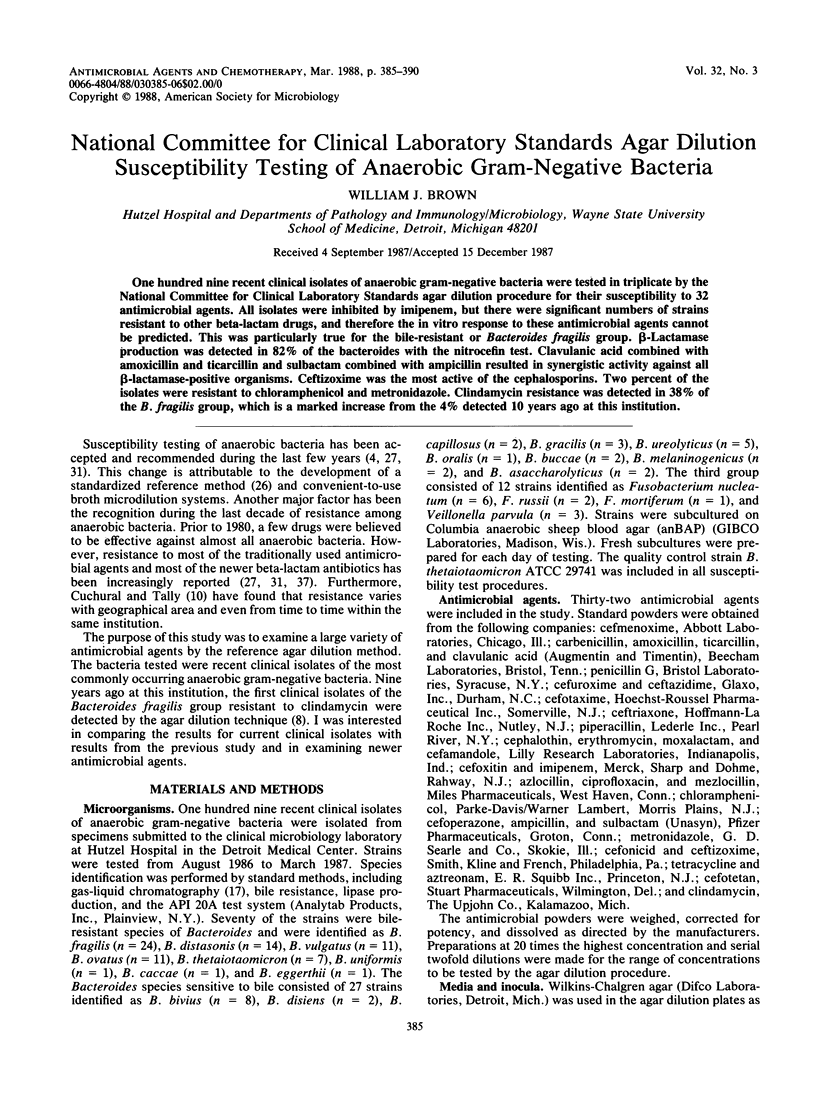
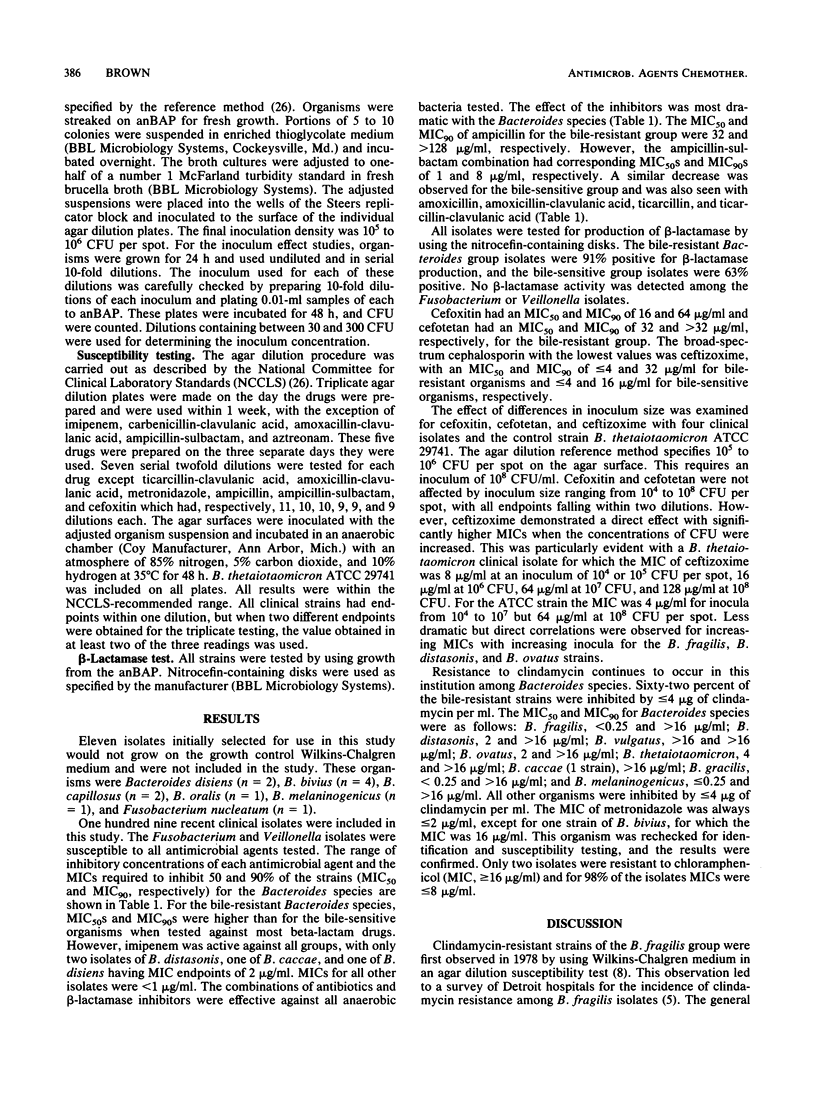
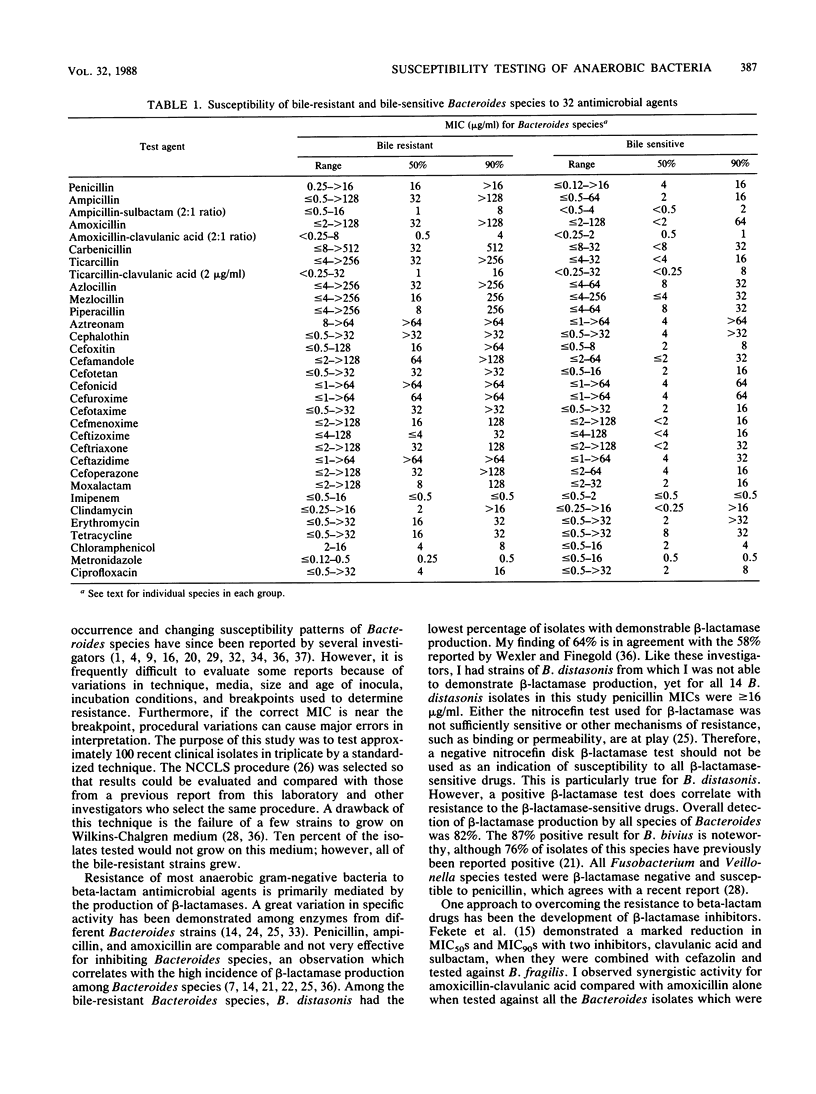
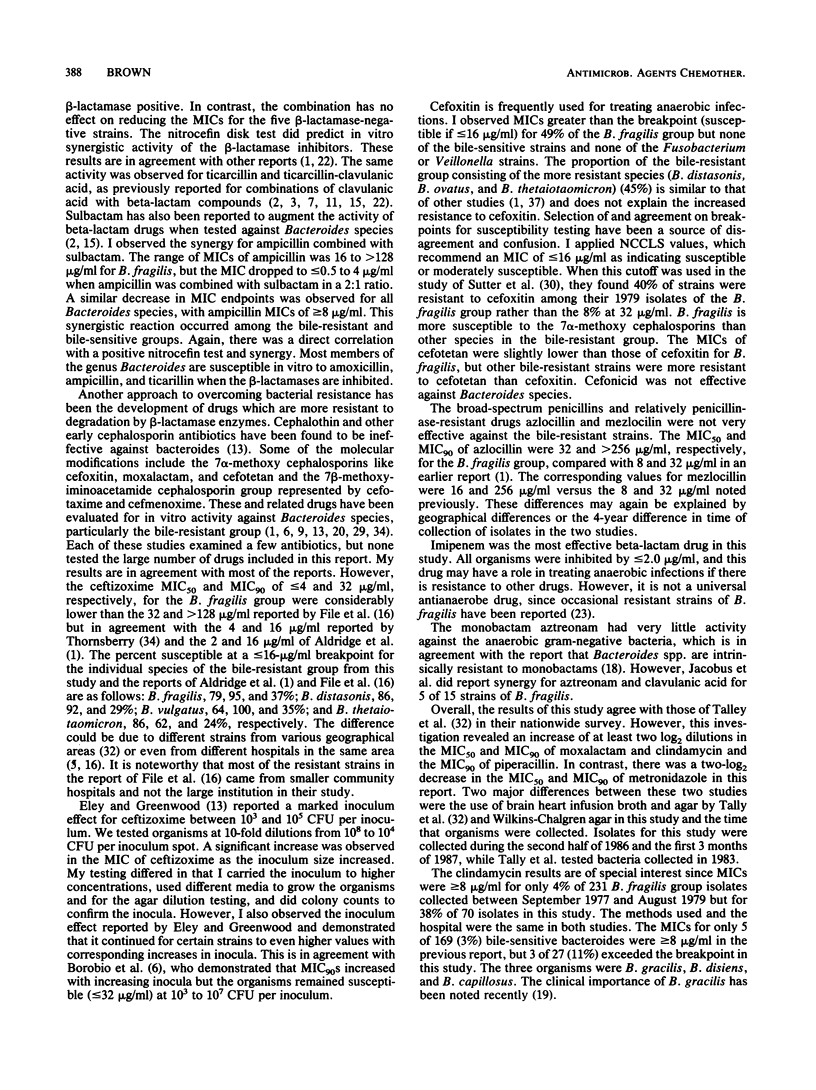

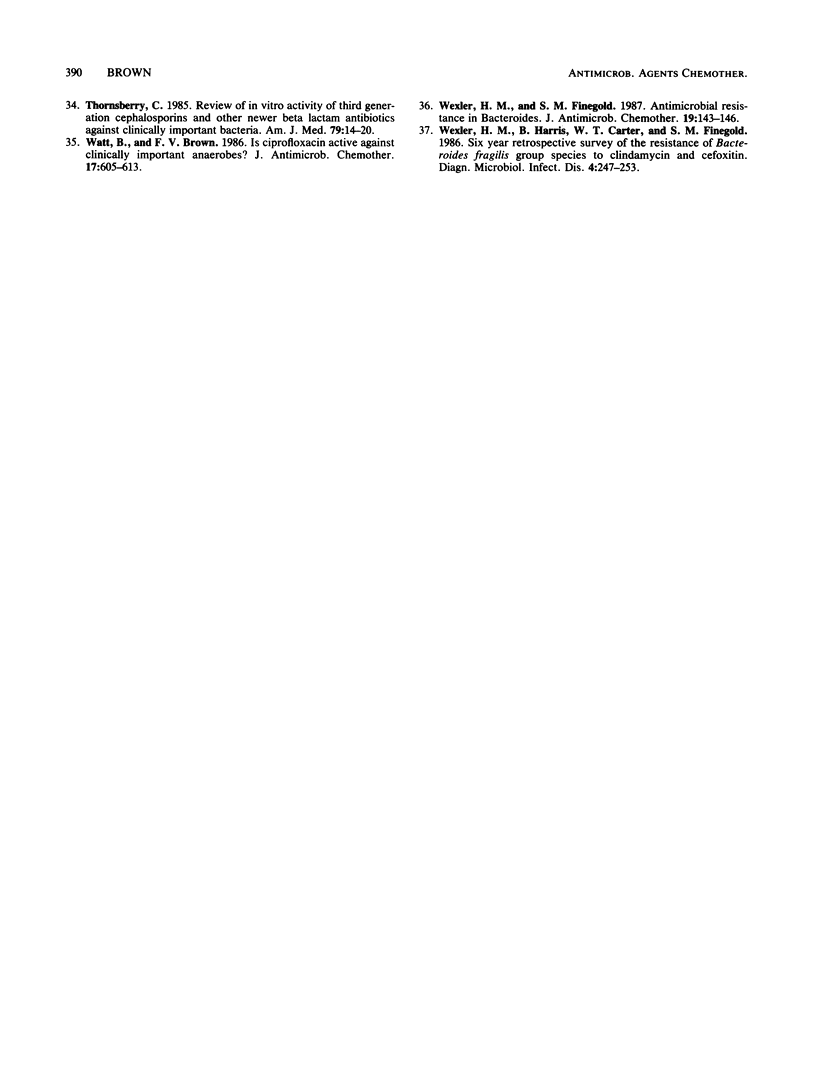
Selected References
These references are in PubMed. This may not be the complete list of references from this article.
- Aldridge K. E., Sanders C. V., Janney A., Faro S., Marier R. L. Comparison of the activities of penicillin G and new beta-lactam antibiotics against clinical isolates of Bacteroides species. Antimicrob Agents Chemother. 1984 Sep;26(3):410–413. doi: 10.1128/aac.26.3.410. [DOI] [PMC free article] [PubMed] [Google Scholar]
- Aldridge K. E., Sanders C. V., Marier R. L. Variation in the potentiation of beta-lactam antibiotic activity by clavulanic acid and sulbactam against multiply antibiotic-resistant bacteria. J Antimicrob Chemother. 1986 Apr;17(4):463–469. doi: 10.1093/jac/17.4.463. [DOI] [PubMed] [Google Scholar]
- Bansal M. B., Chuah S. K., Thadepalli H. Augmentation of the in vitro activity of azlocillin against Bacteroides fragilis by clavulanic acid. Antimicrob Agents Chemother. 1984 Oct;26(4):606–607. doi: 10.1128/aac.26.4.606. [DOI] [PMC free article] [PubMed] [Google Scholar]
- Bawdon R. E., Rozmiej E., Palchaudhuri S., Krakowiak J. Variability in the susceptibility pattern of Bacteroides fragilis in four Detroit area hospitals. Antimicrob Agents Chemother. 1979 Nov;16(5):664–666. doi: 10.1128/aac.16.5.664. [DOI] [PMC free article] [PubMed] [Google Scholar]
- Borobio M. V., Pascual A., Dominguez M. C., Perea E. J. Effect of medium, pH, and inoculum size on activity of ceftizoxime and Sch-34343 against anaerobic bacteria. Antimicrob Agents Chemother. 1986 Oct;30(4):626–627. doi: 10.1128/aac.30.4.626. [DOI] [PMC free article] [PubMed] [Google Scholar]
- Bourgault A. M., Lamothe F. In-vitro activity of amoxycillin and ticarcillin in combination with clavulanic acid compared with that of new beta-lactam agents against species of the Bacteroides fragilis group. J Antimicrob Chemother. 1986 May;17(5):593–603. doi: 10.1093/jac/17.5.593. [DOI] [PubMed] [Google Scholar]
- Brown W. J., Waatti P. E. Susceptibility testing of clinically isolated anaerobic bacteria by an agar dilution technique. Antimicrob Agents Chemother. 1980 Apr;17(4):629–635. doi: 10.1128/aac.17.4.629. [DOI] [PMC free article] [PubMed] [Google Scholar]
- Chow A. W., Finegold S. M. In-vitro activity of ceftizoxime against anaerobic bacteria and comparison with other cephalosporins. J Antimicrob Chemother. 1982 Nov;10 (Suppl 100):45–50. doi: 10.1093/jac/10.suppl_c.45. [DOI] [PubMed] [Google Scholar]
- Cuchural G. J., Jr, Tally F. P. Bacteroides fragilis: current susceptibilities, mechanisms of drug resistance, and principles of antimicrobial therapy. Drug Intell Clin Pharm. 1986 Jul-Aug;20(7-8):567–573. doi: 10.1177/106002808602000712. [DOI] [PubMed] [Google Scholar]
- Edlund C., Nord C. E. Comparative in vitro activities of ciprofloxacin, enoxacin, norfloxacin, ofloxacin and pefloxacin against Bacteroides fragilis and Clostridium difficile. Scand J Infect Dis. 1986;18(2):149–151. doi: 10.3109/00365548609032321. [DOI] [PubMed] [Google Scholar]
- Eley A., Greenwood D. Characterization of beta-lactamases in clinical isolates of Bacteroides. J Antimicrob Chemother. 1986 Sep;18(3):325–333. doi: 10.1093/jac/18.3.325. [DOI] [PubMed] [Google Scholar]
- Eley A., Greenwood D. In vitro activity of ceftizoxime against Bacteroides fragilis: comparison with benzylpenicillin, cephalothin, and cefoxitin. Antimicrob Agents Chemother. 1981 Sep;20(3):332–335. doi: 10.1128/aac.20.3.332. [DOI] [PMC free article] [PubMed] [Google Scholar]
- Fekete T., McGowen J., Cundy K. R. Activity of cefazolin and two beta-lactamase inhibitors, clavulanic acid and sulbactam, against Bacteroides fragilis. Antimicrob Agents Chemother. 1987 Feb;31(2):321–322. doi: 10.1128/aac.31.2.321. [DOI] [PMC free article] [PubMed] [Google Scholar]
- File T. M., Jr, Thomson R. B., Jr, Tan J. S., Salstrom S. J., Jacobs G. A., Johnson L., Tan L. In vitro susceptibility of the Bacteroides fragilis group in community hospitals. Diagn Microbiol Infect Dis. 1986 Nov;5(4):317–322. doi: 10.1016/0732-8893(86)90035-0. [DOI] [PubMed] [Google Scholar]
- Jacobus N. V., Ferreira M. C., Barza M. In vitro activity of azthreonam, a monobactam antibiotic. Antimicrob Agents Chemother. 1982 Nov;22(5):832–838. doi: 10.1128/aac.22.5.832. [DOI] [PMC free article] [PubMed] [Google Scholar]
- Johnson C. C., Reinhardt J. F., Edelstein M. A., Mulligan M. E., George W. L., Finegold S. M. Bacteroides gracilis, an important anaerobic bacterial pathogen. J Clin Microbiol. 1985 Nov;22(5):799–802. doi: 10.1128/jcm.22.5.799-802.1985. [DOI] [PMC free article] [PubMed] [Google Scholar]
- Kesado T., Watanabe K., Asahi Y., Isono M., Ueno K. Comparative antibacterial activities of 7 alpha-methoxy cephalosporins and 7 beta-methoxyiminoacetamido cephalosporins against Bacteroides fragilis. Antimicrob Agents Chemother. 1984 Jan;25(1):131–133. doi: 10.1128/aac.25.1.131. [DOI] [PMC free article] [PubMed] [Google Scholar]
- Lacroix J. M., Lamothe F., Malouin F. Role of Bacteroides bivius beta-lactamase in beta-lactam susceptibility. Antimicrob Agents Chemother. 1984 Nov;26(5):694–698. doi: 10.1128/aac.26.5.694. [DOI] [PMC free article] [PubMed] [Google Scholar]
- Lamothe F., Auger F., Lacroix J. M. Effect of clavulanic acid on the activities of ten beta-lactam agents against members of the Bacteroides fragilis group. Antimicrob Agents Chemother. 1984 May;25(5):662–665. doi: 10.1128/aac.25.5.662. [DOI] [PMC free article] [PubMed] [Google Scholar]
- Lamothe F., Fijalkowski C., Malouin F., Bourgault A. M., Delorme L. Bacteroides fragilis resistant to both metronidazole and imipenem. J Antimicrob Chemother. 1986 Nov;18(5):642–643. doi: 10.1093/jac/18.5.642. [DOI] [PubMed] [Google Scholar]
- Leung T., Williams J. D. beta-Lactamases of subspecies of Bacteroides fragilis. J Antimicrob Chemother. 1978 Jul;4(B):47–54. doi: 10.1093/jac/4.suppl_b.47. [DOI] [PubMed] [Google Scholar]
- Malouin F., Lamothe F. The role of beta-lactamase and the permeability barrier on the activity of cephalosporins against members of the Bacteroides fragilis group. Can J Microbiol. 1987 Mar;33(3):262–266. doi: 10.1139/m87-044. [DOI] [PubMed] [Google Scholar]
- Rosenblatt J. E. Antimicrobial susceptibility testing of anaerobic bacteria. Rev Infect Dis. 1984 Mar-Apr;6 (Suppl 1):S242–S248. doi: 10.1093/clinids/6.supplement_1.s242. [DOI] [PubMed] [Google Scholar]
- Rowland M. D., Del Bene V. E., Lewis J. W. Factors affecting antimicrobial susceptibility of Fusobacterium species. J Clin Microbiol. 1987 Mar;25(3):476–479. doi: 10.1128/jcm.25.3.476-479.1987. [DOI] [PMC free article] [PubMed] [Google Scholar]
- Ryan R. W., Kwasnik I., Tilton R. C. The activity of five cephalosporins against Bacteroides fragilis. Ann Clin Lab Sci. 1982 Jan-Feb;12(1):32–34. [PubMed] [Google Scholar]
- Sutter V. L., Kirby B., Finegold S. M. In vitro activity of cefoxitin and parenterally administered cephalosporins against anaerobic bacteria. Rev Infect Dis. 1979 Jan-Feb;1(1):218–223. doi: 10.1093/clinids/1.1.218. [DOI] [PubMed] [Google Scholar]
- Swenson R. M. Rationale for identification and susceptibility testing of anaerobic bacteria. Rev Infect Dis. 1986 Sep-Oct;8(5):809–813. doi: 10.1093/clinids/8.5.809. [DOI] [PubMed] [Google Scholar]
- Tally F. P., Cuchural G. J., Jr, Jacobus N. V., Gorbach S. L., Aldridge K., Cleary T., Finegold S. M., Hill G., Iannini P., O'Keefe J. P. Nationwide study of the susceptibility of the Bacteroides fragilis group in the United States. Antimicrob Agents Chemother. 1985 Nov;28(5):675–677. doi: 10.1128/aac.28.5.675. [DOI] [PMC free article] [PubMed] [Google Scholar]
- Tally F. P., O'Keefe J. P., Sullivan N. M., Gorbach S. L. Inactivation of cephalosporins by Bacteroides. Antimicrob Agents Chemother. 1979 Nov;16(5):565–571. doi: 10.1128/aac.16.5.565. [DOI] [PMC free article] [PubMed] [Google Scholar]
- Watt B., Brown F. V. Is ciprofloxacin active against clinically important anaerobes? J Antimicrob Chemother. 1986 May;17(5):605–613. doi: 10.1093/jac/17.5.605. [DOI] [PubMed] [Google Scholar]
- Wexler H. M., Finegold S. M. Antimicrobial resistance in Bacteroides. J Antimicrob Chemother. 1987 Feb;19(2):143–146. doi: 10.1093/jac/19.2.143. [DOI] [PubMed] [Google Scholar]
- Wexler H. M., Harris B., Carter W. T., Finegold S. M. Six-year retrospective survey of the resistance of Bacteroides fragilis group species to clindamycin and cefoxitin. Diagn Microbiol Infect Dis. 1986 Mar;4(3):247–253. doi: 10.1016/0732-8893(86)90104-5. [DOI] [PubMed] [Google Scholar]
- de Barbeyrac B., Quentin C., Bébéar C. The activity of ticarcillin in combination with clavulanic acid against Bacteroides species: an in-vitro comparison with other antibiotics. J Antimicrob Chemother. 1986 May;17 (Suppl 100):35–39. doi: 10.1093/jac/17.suppl_c.35. [DOI] [PubMed] [Google Scholar]


